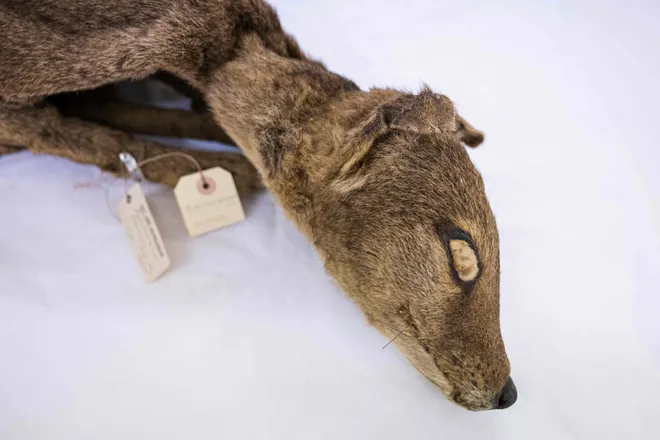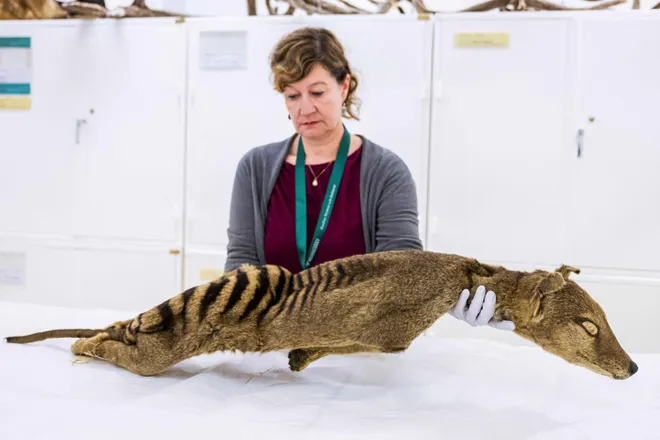Could scientists resurrect the extinct Tasmanian tiger? New breakthrough raises hopes
Tasmanian tigers were hunted to extinction decades ago, but a recent scientific breakthrough has raised hope that the animal and potentially other long-lost species could one day be resurrected.
Scientists were recently able to recover and sequence RNA from a roughly 130-year-old Tasmanian tiger, also known as a thylacine, preserved at a museum in Stockholm. The feat marks the first time RNA molecules have been isolated and decoded from an extinct species, according to a new study published Tuesday in the journal Genome Research.
It may sound like a plot right out of a Jurassic Park movie, but the implications of the study are no mere fiction: Scientists are now one step closer to reviving not only the Tasmanian tiger, but perhaps other extinct species in the future.
Record-setting trip to space:Astronaut Frank Rubio spent a record 371 days in space. The trip was planned to be 6 months

Tasmanian tigers have been extinct for decades
Tasmanian tigers were a large, carnivorous marsupial that experts say went extinct about 80 years ago.
Found on the island of Tasmania off Australia's south coast, the animal had distinct dark stripes running from its shoulders to its tail, as well as a dog-like head with powerful jaws and a pouch, according to the Australian Museum.
At one time, the Tasmanian tiger was widespread throughout continental Australia before it became confined to the island of Tasmania closer to the time of its eradication. The animals preyed upon kangaroos and other marsupials, as well as small rodents and birds.
But the predators were no match for humans, as European colonizers began hunting the species in the late 19th century to eventual extinction to prevent the animals from killing off livestock, according to the Australian Museum.
A brief clip unearthed and digitized in 2020 shows what is believed to be the last remaining Tasmanian tiger living in captivity recorded in 1935. Released by Australia's National Film and Sound Archive, the footage shows a tiger named Benjamin roaming an enclosure in a now-closed zoo about a year before his death.
Though eight sightings of the extinct marsupial have been reported to the Tasmanian government in recent years, none of them have been authenticated and verified.
How scientists hope to resurrect the long lost species

The concept of de-extinction isn't reserved solely for the realm of science fiction series like Jurassic Park.
Though not the goal of the recent study, researchers said that a better understanding of the Tasmanian tiger's genetic makeup could pave the way to bring it back.
That's where ribonucleic acid (RNA) comes into play.
Structurally similar to DNA, the genetic material is present in all living cells and is used to convey information from the genome to the rest of the cell about what it should do. In other words, the RNA molecules are responsible for turning DNA’s genetic instructions into cellular function.
The Tasmanian tiger specimen that researchers chose to examine had been preserved at room temperature at the Swedish Museum of Natural History. After taking three skeletal muscle samples and three skin tissue samples, the team successfully extracted millions of strands of RNA.
By studying the strands, researchers stand to learn more about the biology of the extinct species.
Arachnids:Scientists discover new electric blue tarantula species in Thailand forest
What extinct species have scientists tried to bring back?

This is not the first time that scientists have expressed hope that the Tasmanian tiger and other species once thought lost forever could be resurrected.
In 2021, Colossal Laboratories and Biosciences launched with the express purpose of using gene editing to resurrect none other than the famed woolly mammoth. The research set out to reprogram elephant DNA with mammoth characteristics, like thick hair and layers of fat, to help the hybrid animals survive in the Siberian tundra.
It wasn't just for vanity that the Colossal team hoped to revive the ancient behemoth: Researchers believed that if the mammoths could be created, they could revitalize grasslands in the Arctic.
Since then, the genetic engineering company has also revealed intentions to research ways to resurrect the dodo and yes, even the Tasmanian tiger. Using gene editing technology on a tiger genome to create an embryo, the team hopes to eventually reestablish the Tasmanian tiger on the island of Tasmania.
“I now believe that in ten years’ time we could have our first living baby thylacine since they were hunted to extinction close to a century ago," Prof. Andrew Pask, who oversees the TIGRR Lab, said last year in a description of the project on the university's website.
Researchers at the University of Copenhagen and Shantou University in China also revealed plans last year to resurrect a smaller mammal, the Christmas Island rat.
'Eight-legged roommate'?It's spider season. Here's why you're seeing more around the house

Eric Lagatta covers breaking and trending news for USA TODAY. Reach him at elagatta@gannett.com
Disclaimer: The copyright of this article belongs to the original author. Reposting this article is solely for the purpose of information dissemination and does not constitute any investment advice. If there is any infringement, please contact us immediately. We will make corrections or deletions as necessary. Thank you.







